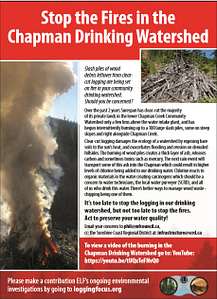Dear Ms. Loveys,
Please note attached a video clip of the slash burn recorded Sept. 13th in the Chapman Drinking Watershed.
The total number of slash piles has not been systemically counted, however taking into consideration the large area clearcut by the private land owner (Surespan) on the east and west of this watershed the estimated number of piles is 100+/-. It would appear that approx. 4 piles on the west side have been ignited at this time.
A recent Yale Environment article ‘How Wildfires are Polluting Rivers and Threatening Water Supplies‘ sites the effects of wildfires on drinking watersheds across North America. While slash pile burning is not as wide spread as a wildfire, the effects of woody debris being burnt (ignited) from a slash pile leads to similar toxic gases being released and vulnerable soil conditions being left behind is similar.
Below are key quotes from the article that should alarm the SCRD as the watershed purveyor. Due to the science that’s looking at the outcomes of fire in drinking watersheds, our organization concludes that what is happening in the Chapman Drinking Watershed poses a health risk to water consumers.
To that end, will the SCRD contact Vancouver Coastal Health tomorrow morning and together make a request to the Managed Forest Council to issue a Stop Work order to the member company Surespan?
The falling ash will have to be filtered out by the filtration plant which could very well lead to higher maintenance costs born by the taxpayer. The article also sites several negative implications from the consequences of fire on water quality, including – .“is the dissolved organic carbon that is released by wildfires. When mixed with the chlorine that is used to treat water, it can produce carcinogens that most treatment plant technicians don’t have the expertise to manage.”
The RD should not idly stand by and have all of these slash piles burnt and just hope for the best. Now is the time to act.
Please advise on the RD’s next steps on this issue.
Ross Muirhead
Forest Protection Campaigner
ELF
604-740-5654
As hotter and dryer conditions spawn an increasing number of wildfires in North America and around the world, one of the overlooked impacts of these worsening conflagrations is on aquatic environments and drinking water supplies. Just as wildfires can have a regenerative effect on woodlands, so, too, can fires provide some benefits to streams and rivers in burned areas. But scientists are warning that intense and repeated fires can damage the ecology of waterways by exposing them to the sun’s heat, exacerbating flooding and erosion along denuded hillsides, and releasing toxins such as mercury that are often liberated from soil and tree trunks.
Water treatment plants in those places were overwhelmed by sedimentation, dissolved organic carbon, and chemicals that were released by fire.
The intense fires removed many of the trees from parts of the mountain landscape. In the hot drought conditions that followed, the soils in those denuded landscapes baked. Some spring-fed streams stopped flowing. Chemical compounds that were vaporized by the fire got driven into the soil. As they condensed, they formed an impervious layer just below the surface.
Without trees, vegetation, and a stable soil structure to absorb the heavy rains that followed,tons of ash, debris, heavy metals, and nutrients were flushed through the watershed.
The biggest issue, according to Emelko, is the dissolved organic carbon that is released by wildfires. When mixed with the chlorine that is used to treat water, it can produce carcinogens that most treatment plant technicians don’t have the expertise to manage. To deal with the challenges, Fort McMurray is now spending more than twice as much on chemicals as it did before the fire burned along the Athabasca River. Other municipalities that purify water supplies with chlorine could face a similar threat in the wake of severe forest fires, scientists say.
John Moody says there are two things to watch for in the future: the intensity and frequency of forest fires, and the extreme precipitation – those that unleash a lot of rain in 30 minutes – that follow a fire weeks and months after it is extinguished, when soils may not be able to absorb as much moisture as they normally do. Those are the events that can cause severe flooding, extreme sedimentation, and the liberation of undesirable chemicals.
 Please note attached a video clip of the slash burn recorded Sept. 13th in the Chapman Drinking Watershed.
Please note attached a video clip of the slash burn recorded Sept. 13th in the Chapman Drinking Watershed.